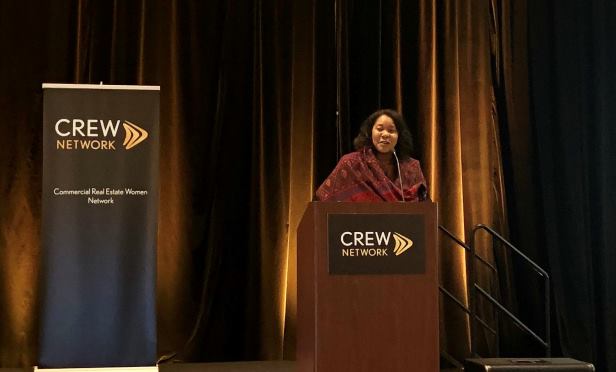 Regina Wallace-Jones is both an elected official (East Palo Alto mayor) and a tech executive.
Regina Wallace-Jones is both an elected official (East Palo Alto mayor) and a tech executive.
SANTA CLARA, CA—When Regina Wallace-Jones was a student at Stanford University in 1993, East Palo Alto was the murder capital of the Bay Area. When she returned as a full-time resident in 2002, that nickname had been removed.
Indeed, since its founding around 1849, East Palo Alto has experienced erratic growth and frequent conflict at times but many aspects of the 2.5-square-mile city have changed since then. Wallace-Jones, East Palo Alto mayor, shared some of that history and a penchant for change in a keynote speech during the 2020 CREW Network Winter Leadership Summit held last week at the Santa Clara Marriott.
She pointed out that the city's roots began in farming. In fact, trade alternately focused on ranching, transportation and shipping, brick manufacturing, farming, flower growth, and servicing travelers of Bayshore Highway and the Dumbarton Bridge. After all, for most of its history, East Palo Alto was part of unincorporated San Mateo County.
Large tracts were annexed by Menlo Park and Palo Alto from the late 1940s to the early 1960s. While it did not have an official boundary until it incorporated in 1983, the area historically regarded as East Palo Alto was much larger than the city's current border of 2.5 square miles.
The original inhabitants were Ohlone/Costanoan Native Americans. Spanish ranchers took over, followed by Caucasian speculators and settlers. For a time, Chinese laborers were prevalent. Asian and Italian flower growers preceded the flood of middle-class Caucasians drawn to post-war housing developments. East Palo Alto later became the largest African American community on the Peninsula. Today, the city possesses a multi-ethnic population which includes a large number of Hispanics and Pacific Islanders.
"I understand where we've been and I am excited to reposition East Palo Alto's destiny," Wallace-Jones told the audience.
Numerous characteristics have attracted people to the area: the price of land and housing, a rural-like setting, its centralized location, proximity to transportation and San Francisco Bay, and mild weather. At present, there is a mix of small industrial, agricultural and commercial businesses, but that is growing.
"We are the gateway to Silicon Valley," Wallace-Jones pointed out. "It is similar to a triangle made up of Stanford, Facebook and Google, and East Palo Alto is in the middle. We now have a number of development projects in the works but with this come the challenges of traffic and a shortage of housing."
However, the city aims to change that, with developments to include the property at 965 Weeks St., which East Palo Alto purchased in 2012 for the purposes of building a future affordable housing development. Several factors, including a challenging economic climate, delayed the development of property. Recently, the city improved its financial and staffing capacity to advance the project. About a year ago, East Palo Alto's city council selected the team of MidPen Housing Corporation and EPA CAN DO to develop a future 100% affordable housing community on the city-owned property, according to the city website.
In addition, East Palo Alto completed a flood-control project that will protect homes from a 100-year flood event, greatly reduced its violent crime rate, built several commercial developments to establish a more stable revenue base, is nearing completion on a bicycle-pedestrian bridge over US Highway 101 to link the east and west sides of the city, revitalized the Cooley Landing open space and a new interpretive center, and has other projects in the pipeline including an arts and cultural center, and new buildings for The Primary School founded by Facebook CEO Mark Zuckerberg and his wife, Priscilla Chan.
As of late, East Palo Alto is also updating the 1999 General Plan and Zoning Ordinance. Funded by the Strategic Growth Council, the general plan update targets improving the health of city residents and is therefore referred to as a Targeted General Plan. In fall 2012, East Palo Alto selected Raimi + Associates to engage the community and refine this plan.
Each city and county adopts and updates a general plan to guide the growth and land development of individual communities, for both the current period and the long term. The general plan is the foundation for establishing goals, purposes, zoning and activities allowed on each land parcel to provide compatibility and continuity to the entire region as well as each individual neighborhood. Through land use policies and measures that are chosen by city residents, and closely aligned with 26 indicators that are associated with public health, the plan will be accompanied by a comprehensive revision of the zoning ordinance to implement the residents' vision.
After being raised in the city of West Covina, CA, a city not too unlike East Palo Alto, Wallace-Jones studied engineering and technology policy, with the hopes of using technology for social advancement. She holds a bachelor of science in electrical engineering from Stanford University and a master's degree in public policy with emphasis in technology policy from UCLA.
Wallace-Jones is not only a long-time resident of East Palo Alto, she is a community advocate and tech executive. She is the founding board president of StreetCode Academy, a patron of Black Girls Code, a board member for Women Who Code, and a partner of the Lean In Foundation to advocate for women pursuing professional ambition.
Wallace-Jones is senior vice president and general manager of MindBody Inc. Previously, she was chief of staff and head of product operations at eBay Inc. and also served as a tech executive at Yahoo and Facebook.
© Touchpoint Markets, All Rights Reserved. Request academic re-use from www.copyright.com. All other uses, submit a request to [email protected]. For more inforrmation visit Asset & Logo Licensing.







